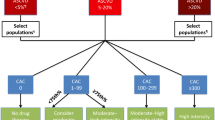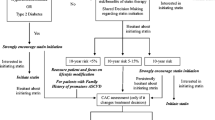Abstract
Objectives
To compare the prognostic value of individual CT-derived coronary artery disease (CAD) characteristics across categories of clinical cardiovascular risk.
Methods
The central core laboratory assessed coronary artery calcium (CAC), obstructive CAD (stenosis ≥ 50%), and high-risk plaque (HRP) in stable outpatients with suspected CAD enrolled in the PROMISE trial. Multivariable Cox regression models (endpoint: unstable angina, nonfatal myocardial infarction, or all-cause mortality; median follow-up: 2 years) were used to compare hazard ratios (HR) of the CT measures between low-borderline (< 7.5%) and moderate-high (≥ 7.5%) atherosclerotic cardiovascular disease (ASCVD) risk based on the pooled cohort equation.
Results
Among 4356 included patients (aged 61 ± 8 years, 52% women), 67% had ASCVD risk ≥ 7.5%. Stratified by ASCVD risk, CAD ≥ 50% had nearly threefold greater HR in individuals with ASCVD < 7.5% (aHR, 6.85; 95% CI, 2.33–20.15; p < 0.001) vs. ASCVD ≥ 7.5% (aHR: 2.66, 95% CI: 1.67–4.25, p < 0.001; interaction p = 0.041). CAC predicted events solely in ASCVD ≥ 7.5% patients (aHR: 1.92, 95% CI: 1.01–3.63, p = 0.045; interaction p = 0.571), while HRP predicted events only in ASCVD < 7.5% (aHR: 3.11, 95% CI: 1.09–8.85, p = 0.034; interaction p = 0.034).
Conclusions
Prognostic values of CT-derived CAD characteristics differ by ASCVD risk categories. While CAD ≥ 50% has the highest prognostic value regardless of ASCVD risk, CAC is prognostic in high and HRP in low ASCVD risk. These findings suggest that CAD ≥ 50% and HRP detection rather than CAC scoring may better risk-stratify symptomatic low-risk patients and thus potentially improve downstream care.
Key Points
• Prognostic value of individual CT-derived CAD characteristics differs by categories of cardiovascular risk.
• Presence of obstructive coronary artery stenosis ≥ 50% has the highest prognostic value regardless of cardiovascular risk.
• Coronary artery calcium is independently prognostic in high and high-risk plaque features in low cardiovascular risk.


Similar content being viewed by others

Data Availability
This study is a substudy of the PROMISE trial, which was sponosored by the NIH. Therefore, the data of the partent trial will be made available in the future according to NIH guidelines.
Abbreviations
- ACC/AHA:
-
American College of Cardiology/American Heart Association
- ASCVD:
-
Atherosclerotic cardiovascular disease
- CAC:
-
Coronary artery calcium
- CAD:
-
Coronary artery disease
- CI:
-
Confidence interval
- CT:
-
Computed tomography
- ESC:
-
European Society of Cardiology
- HDL:
-
High-density lipoprotein
- HR:
-
Hazard ratio
- HRP:
-
High-risk plaque
- LDL:
-
Low-density lipoprotein
- PROMISE:
-
Prospective Multicenter Imaging Study for Evaluation of Chest Pain
- SCOT-HEART:
-
Scottish Computed Tomography of the Heart
References
Douglas PS, Hoffmann U, Patel MR et al (2015) Outcomes of anatomical versus functional testing for coronary artery disease. N Engl J Med 372:1291–1300. https://doi.org/10.1056/NEJMoa1415516
SCOT-HEART Investigators, Newby DE, Adamson PD et al (2018) Coronary CT Angiography and 5-year risk of myocardial infarction. N Engl J Med 379:924–933. https://doi.org/10.1056/NEJMoa1805971
SCOT-HEART investigators (2015) CT coronary angiography in patients with suspected angina due to coronary heart disease (SCOT-HEART): an open-label, parallel-group, multicentre trial. Lancet 385:2383–2391. https://doi.org/10.1016/S0140-6736(15)60291-4
(2022) CT or invasive coronary angiography in stable chest pain. N Engl J Med 0:null. https://doi.org/10.1056/NEJMoa2200963
Knuuti J, Wijns W, Saraste A et al (2019) ESC Guidelines for the diagnosis and management of chronic coronary syndromesThe Task Force for the diagnosis and management of chronic coronary syndromes of the European Society of Cardiology (ESC). Eur Heart J. https://doi.org/10.1093/eurheartj/ehz425
Gulati M, Levy PD, Mukherjee D et al (2021) 2021 AHA/ACC/ASE/CHEST/SAEM/SCCT/SCMR guideline for the evaluation and diagnosis of chest pain: a report of the American College of Cardiology/American Heart Association Joint Committee on Clinical Practice Guidelines. J Cardiovasc Comput Tomogr. https://doi.org/10.1016/j.jcct.2021.11.009
Goff DC, Lloyd-Jones DM, Bennett G et al (2014) 2013 ACC/AHA guideline on the assessment of cardiovascular risk: a report of the American College of Cardiology/American Heart Association Task Force on Practice Guidelines. J Am Coll Cardiol 63:2935–2959. https://doi.org/10.1016/j.jacc.2013.11.005
Grundy SM, Stone NJ, Bailey AL, et al (2018) 2018 AHA/ACC/AACVPR/AAPA/ABC/ACPM/ADA/AGS/APhA/ASPC/NLA/PCNA guideline on the management of blood cholesterol: a report of the American College of Cardiology/American Heart Association Task Force on Clinical Practice Guidelines. J Am Coll Cardiol 25709. https://doi.org/10.1016/j.jacc.2018.11.003
Detrano R, Guerci AD, Carr JJ et al (2008) Coronary calcium as a predictor of coronary events in four racial or ethnic groups. N Engl J Med 358:1336–1345. https://doi.org/10.1056/NEJMoa072100
Budoff MJ, Thomas M, Maros F et al (2017) Prognostic value of coronary artery calcium in the PROMISE study (Prospective Multicenter Imaging Study for Evaluation of Chest Pain). Circulation 136:1993–2005. https://doi.org/10.1161/CIRCULATIONAHA.117.030578
Hoffmann U, Massaro JM, D’Agostino RB, et al (2016) Cardiovascular event prediction and risk reclassification by coronary, aortic, and valvular calcification in the Framingham Heart Study. J Am Heart Assoc 5:. https://doi.org/10.1161/JAHA.115.003144
Bittencourt MS, Hulten E, Ghoshhajra B et al (2014) Prognostic value of nonobstructive and obstructive coronary artery disease detected by coronary computed tomography angiography to identify cardiovascular events. Circ Cardiovasc Imaging 7:282–291. https://doi.org/10.1161/CIRCIMAGING.113.001047
Bittner DO, Thomas M, Matt B et al (2020) Prognostic value of coronary CTA in stable chest pain. JACC Cardiovasc Imaging 13:1534–1545. https://doi.org/10.1016/j.jcmg.2019.09.012
Hoffmann U, Ferencik M, Udelson JE et al (2017) Prognostic value of noninvasive cardiovascular testing in patients with stable chest pain: insights from the promise trial (prospective multicenter imaging study for evaluation of chest pain). Circulation. https://doi.org/10.1161/CIRCULATIONAHA.116.024360
Ferencik M, Mayrhofer T, Bittner DO et al (2018) Use of high-risk coronary atherosclerotic plaque detection for risk stratification of patients with stable chest pain: a secondary analysis of the PROMISE randomized clinical trial. JAMA Cardiol. https://doi.org/10.1001/jamacardio.2017.4973
Feuchtner G, Kerber J, Burghard P et al (2017) The high-risk criteria low-attenuation plaque <60 HU and the napkin-ring sign are the most powerful predictors of MACE: a long-term follow-up study. Eur Heart J Cardiovasc Imaging 18:772–779. https://doi.org/10.1093/ehjci/jew167
Douglas PS, Hoffmann U, Lee KL et al (2014) PROspective Multicenter Imaging Study for Evaluation of chest pain: rationale and design of the PROMISE trial. Am Heart J 167:796-803.e1. https://doi.org/10.1016/j.ahj.2014.03.003
Agatston AS, Janowitz WR, Hildner FJ et al (1990) Quantification of coronary artery calcium using ultrafast computed tomography. J Am Coll Cardiol 15:827–832
Hansson GK (2005) Inflammation, atherosclerosis, and coronary artery disease. N Engl J Med 352:1685–1695. https://doi.org/10.1056/NEJMra043430
Aditya G, Dey AK, Abhishek C et al (2020) Chronic stress-related neural activity associates with subclinical cardiovascular disease in psoriasis. JACC Cardiovasc Imaging 13:465–477. https://doi.org/10.1016/j.jcmg.2018.08.038
Hansildaar R, Vedder D, Baniaamam M et al (2021) Cardiovascular risk in inflammatory arthritis: rheumatoid arthritis and gout. Lancet Rheumatol 3:e58–e70. https://doi.org/10.1016/S2665-9913(20)30221-6
Subramanian S, Tawakol A, Burdo TH et al (2012) Arterial inflammation in patients with HIV. JAMA 308:379–386. https://doi.org/10.1001/jama.2012.6698
Osborne MT, Shin LM, Mehta NN et al (2020) Disentangling the links between psychosocial stress and cardiovascular disease. Circ Cardiovasc Imaging 13:e010931. https://doi.org/10.1161/CIRCIMAGING.120.010931
Ahmed T, Osborne MT, Ying W et al (2019) Stress-associated neurobiological pathway linking socioeconomic disparities to cardiovascular disease. J Am Coll Cardiol 73:3243–3255. https://doi.org/10.1016/j.jacc.2019.04.042
Delfino RJ, Staimer N, Tjoa T et al (2008) Circulating biomarkers of inflammation, antioxidant activity, and platelet activation are associated with primary combustion aerosols in subjects with coronary artery disease. Environ Health Perspect 116:898–906. https://doi.org/10.1289/ehp.11189
Delfino RJ, Tjoa T, Gillen DL, et al (2010) Traffic-related air pollution and blood pressure in elderly subjects with coronary artery disease. Epidemiol Camb Mass 21:https://doi.org/10.1097/EDE.0b013e3181d5e19b
Osborne MT, Radfar A, Hassan MZO et al (2020) A neurobiological mechanism linking transportation noise to cardiovascular disease in humans. Eur Heart J 41:772–782. https://doi.org/10.1093/eurheartj/ehz820
Budoff MJ, Young R, Burke G et al (2018) Ten-year association of coronary artery calcium with atherosclerotic cardiovascular disease (ASCVD) events: the multi-ethnic study of atherosclerosis (MESA). Eur Heart J 39:2401–2408. https://doi.org/10.1093/eurheartj/ehy217
Pursnani A, Chou E, Zakroysky P et al (2015) Utility of coronary artery calcium scanning beyond coronary CT angiography in the emergency department evaluation for acute chest pain: The ROMICAT II Trial. Circ Cardiovasc Imaging 8:e002225. https://doi.org/10.1161/CIRCIMAGING.114.002225
Hoffmann U, Massaro JM, Fox CS et al (2008) Defining normal distributions of coronary artery calcium in women and men (from the Framingham Heart Study). Am J Cardiol 102:1136-1141.e1. https://doi.org/10.1016/j.amjcard.2008.06.038
Yeboah J, Young R, McClelland RL et al (2016) Utility of nontraditional risk markers in atherosclerotic cardiovascular disease risk assessment. J Am Coll Cardiol 67:139–147. https://doi.org/10.1016/j.jacc.2015.10.058
Pál M-H, Schlett CL, Hatem A et al (2012) The napkin-ring sign indicates advanced atherosclerotic lesions in coronary CT angiography. JACC Cardiovasc Imaging 5:1243–1252. https://doi.org/10.1016/j.jcmg.2012.03.019
Ladapo JA, Hoffmann U, Lee KL, et al Changes in medical therapy and lifestyle after anatomical or functional testing for coronary artery disease. J Am Heart Assoc 5:e003807. https://doi.org/10.1161/JAHA.116.003807
Funding
The current work was supported by the following PROMISE grants: R01HL098237, R01HL098236, R01HL098305, and R01HL098235.
Author information
Authors and Affiliations
Corresponding authors
Ethics declarations
Guarantor
The scientific guarantor of this publication is Dr. Borek Foldyna.
Conflict of interest
The authors of this manuscript declare no relationships with any companies whose products or services may be related to the subject matter of the article.
Statistics and biometry
One of the authors (Prof. Thomas Mayrhofer) has significant statistical expertise, and no complex statistical methods were necessary for this paper.
Informed consent
Local and central institutional review boards approved the study; informed consent was waived.
Ethical approval
Local and central institutional review boards approved the study.
Methodology
• Sub-analysis of a randomized controlled trial.
Additional information
Publisher's note
Springer Nature remains neutral with regard to jurisdictional claims in published maps and institutional affiliations.
Supplementary Information
Below is the link to the electronic supplementary material.
Rights and permissions
Springer Nature or its licensor (e.g. a society or other partner) holds exclusive rights to this article under a publishing agreement with the author(s) or other rightsholder(s); author self-archiving of the accepted manuscript version of this article is solely governed by the terms of such publishing agreement and applicable law.
About this article
Cite this article
Foldyna, B., Mayrhofer, T., Lu, M.T. et al. Prognostic value of CT-derived coronary artery disease characteristics varies by ASCVD risk: insights from the PROMISE trial. Eur Radiol 33, 4657–4667 (2023). https://doi.org/10.1007/s00330-023-09430-5
Received:
Revised:
Accepted:
Published:
Issue Date:
DOI: https://doi.org/10.1007/s00330-023-09430-5



